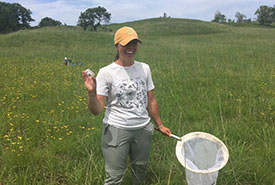Pollinators and the future of food

Bumblebee, Southern Norfolk Sand Plain, ON (Photo by Mhairi McFarlane/NCC Staff)
Starting my day with a variety of fresh fruits is my version of a fresh cup of coffee. One of my fondest memories is from my time in Vancouver several years ago, visiting a nearby park filled with highbush blueberries. A friend and I would spend...
Spotting the spotted wintergreen: Research on rare woodland plants in Ontario

A tagged spotted wintergreen plant (Photo by Amy Wiedenfeld/NCC staff)
As summer approaches, I look forward to getting out into the field. This includes visiting many of the spotted wintergreen populations in Ontario for my PhD research, supported by the Weston Family Conservation Science Fellowship Program. Spotted...
When it comes to wetland restoration and maximizing soil carbon storage, location matters

A day in the field at the Long Point Biosphere Reserve (Photo by Amanda Loder)
As appreciation from the public grows for the ecological and cultural values of wetlands, there is increasing demand to bring back those wetlands that have been converted or altered. Wetlands were once widespread across the temperate region of...
Marshland in the Long Point Region has a long history — and holds a lot of carbon

A day in the field at the Long Point Biosphere Reserve (Photo by Amanda Loder)
There is growing discussion on the role of wetlands as natural climate solutions; meaning how we can conserve and restore these ecosystems to leverage carbon storage and greenhouse gas uptake from the atmosphere. This could ultimately help slow...
A day in the life of a field biologist

Field technician Breanne Kenner with a successful catch! (Photo by NCC)
There are numerous findings in the world of science, and conservation biology specifically, that would not be possible without field work. As part of my conservation internship with the Nature Conservancy of Canada (NCC), I have been given the...
A glimpse into the lives of outdoor cats

Ever wonder what your cat is thinking? (Photo by Pixabay)
Have you ever wondered what your cat is doing and where it’s going when it’s outside? For my master’s research at the University of Guelph, I joined a team seeking to answer these questions using custom-built cameras. These...
Keep calm and count on: Big Valley MAPS station

American restart adult (ASY) male (Photo by NCC)
After many years working in the field of ecology and conservation, it can become easy to take for granted the unique and spectacular things you get to do and the beautiful landscapes you get to see on a regular basis. Being aware of this, I always...
Talking data: How community science informs conservation

Volunteer capturing data with a smartphone at a NCC BioBlitz event (Photo by Brent Calver)
What comes to mind when you hear the word data? For many, data conjures ideas of numbers and computers, with scientists performing complex statistical analyses. While that generalization is reasonably accurate, it is important to understand that...
World Habitat Day 2021: There is no protected habitat too small to benefit biodiversity

Great blue heron with a cityscape in the background (Photo by iStock)
October 4 is World Habitat Day, which has been celebrated annually by the United Nations since 1986. This year’s theme is accelerating urban climate action. The day is followed by Urban October, a month where we are encouraged to reflect on...
Discoveries in little-known fungi: Adventures in looking at lichens

Opegrapha parmeliiperda, cross section of one fruiting body showing four-celled spores developing inside spore sacs; blue colour result of treatment with potassium hydroxide followed by Lugol’s iodine solution. (Photo courtesy of Kendra Driscoll)
I used to think that scientists understood the basics about most living things on Earth, that new species were all discovered long ago by people like Linnaeus and Darwin. Maybe you could find new species in the most remote corners of the planet,...

